This is being posted here for anyone who also has a pond/pool/spa. After any feedback, I'll be posting it on the pond/pool/spa forums:
Mega Powerful Algae Remover -- Does Not Require Chlorine, Chemicals, or Brushes
A recent development in the aquarium hobby has brought about a rather easy way to get rid of the algae or slime that you may have been fighting with for years in your pond/pool/spa. This development can be used on swimming pools (including salt), spa's, fish ponds, aquascaping, watergardens, or any other body of water that develops nuisance algae or slime that you want to get rid of. And it may offer an alternative to potential pool/spa owners, who otherwise are avoiding having a pool/spa altogether because of chemicals.
It is called an Algae Scrubber. No it's not a brush! Instead it's a device you build (because they are not for sale) that MOVES the growth of algae to a hidden area of your pond/pool/spa, so that algae and slime will NOT grow in the visible areas. It does this by "scrubbing" (removing) nutrients out of the water that cause algae and slime in the first place. Then, since the water has less of these nutrients, the visible parts of your pond/pool/spa remain algae and slime free. In other words, an Algae Scrubber makes conditions very "algae friendly" in the hidden parts (so that algae grows there instead), and makes conditions very "algae unfriendly" in the visible areas that you want to look at and use. And it does this without requiring chlorine, chemicals, or brushes, although you can certainly still use these if you want.
Algae Scrubbers can be built into sealed black boxes (for indoor spa's), or set into open troughs (for pools), or laid into the ground (for large ponds). Here is one version of an outdoor small-pond Algae Scrubber, which has been positioned next to the inflatable pond so you can see it work:
Here is a close-up of the same Algae Scrubber just a few days later (picture taken at night):
As you can see, the light (in this case, the sun) and the water-flow down the Algae Scrubber, worked together to grow a lot of algae. And since the algae grows on the Scrubber, it does NOT grow in the pond/pool/spa. You just clean this algae off of the Algae Scrubber once a week (feed it to the garden!) and you are done. Here is the pond itself (a koi fish pond, pictured at night) so you can see the old nuisance algae, and also see where the nuisance algae is clearing away. This pond originally did not have an Algae Scrubber, and the bottom was completely covered in thick green algae and slime. After just a few weeks, it's almost half gone (and this is with daily feeding of the fish)...
The basic idea of an Algae Scrubber is for rapidly-flowing, THIN layers of water to flow over a rough screen. A rapid flow delivers the most nutrients to the screen, and a thin layer of water keeps from blocking the light. This, combined with a rough surface for the algae to attach to, gives you much stronger conditions for growth of algae here compared to your pond/pool/spa (which has slow flow, thick water, and smooth surfaces). A basic Algae Scrubber has a screen in a container, with a pump that will move the water over the screen. Here is a typical diagram:
And here is an actual one made out of pvc and a plastic screen:
Basically, as water flows down the screen, the rapid flow (algae LOVES rapid flow) and the strong light (algae LOVES strong light) cause algae to grow here more than anywere else in the pond/pool/spa. And since it grows here on the screen, it does NOT grow in the parts of the pond/pool/spa that you look at and use. Same for slime. Here are some examples of small Algae Scrubbers, mostly for aquarium use and powered by light bulbs; they can be sized, light-powered, and hidden according to the required pond/pool/spa use:
This pond scrubber is normally hidden. Note the rapid flow off the bottom...
You might wonder why someone would consider adding another "device" like an Algae Scrubber to their pond/pool/spa, when current devices/chemicals seem to do just fine. Well, one answer might seem to be to give an option to folks who want less "chemicals" in their water. But the real reason is to actually reduce the need for current devices and chemicals for everyone (not just the sensitive types), and thus also to reduce the maintenance time required. Total elimination of some devices is a possibility too; it just depends on the goal and the ability of the designer. The main reason that Algae Scrubbers can lower required maintenance is because they GROW, meaning that as the load (or neglect) in the pond/pool/spa increases, the Algae Scrubber's growth increases to match it, thus absorbing more nutrients and increasing the filtering, and thus keeping things in check. This is in contrast to traditional devices/chemicals which tend to reduce (not increase) their filtering capacity as the load or neglect increases. After all, think about why you have to "shock" a pool or spa in the first place: Because the algae is GROWING. With an Algae Scrubber, the algae still grows, but it does so on the Scrubber instead (and it uses up phosphate and metals in the process.)
Algae Scrubbers were invented in the 1970's by Walter Adey (he calls them Algal Turf Scrubbers, "ATS"), who at the time was working at the Smithsonian in the aquatics department. Now he uses Algae Scrubbers to clean lakes and rivers:
http://www.algalturfscrubber.com/point.htm
But for smaller bodies of water (aquariums, ponds, pools, spa's), Algae Scrubbers were hardly ever manufactured, sold, or even DIY'd, because the designs at that time were just too complex. That is, until August of 2008. It was then discovered that by turning the Algae Scrubber vertical (like a curtain) instead of horizontal (like a carpet), you would get very good results using an easy to build device. Thousands of aquarium owners began building their own Algae Scrubbers, and almost every single one wiped out their out-of-control nuisance algae problems within 8 weeks. And keep in mind that aquariums have food and poop going into them all the time, yet the Algae Scrubbers still keep the algae and slime away.
Here are some advantages of an Algae Scrubber:
o Basic idea is to be able to use less devices/chemicals, but still be algae and slime free, while having to monitor the water less (because Algae Scrubbers "grow" to match the demand).
o Removes ammonia, nitrate and phosphate, which are what causes nuisance algae to grow in the first place.
o Removes slime too, because slime is bacterial buildup, and bacteria require ammonia, nitrate and phosphate just like algae do.
o Removes (not just sequesters) metals like copper and iron, so you get less green hair and less brown stains (just think how much iron is in spinach!)
o Reduces pathogens, because they require ammonia, nitrate and phosphate too.
o Is unaffected by dirt.
o Does not alter calcium.
o Does not reduce its effectiveness in sunshine (actually, the opposite).
o Does not reduce its effectiveness over time (actually gets stronger the more it grows).
o Does not reduce its effectiveness (or "burn off") in warm/hot water.
o Provides aeration, because of the waterfall action, and also because of the photosynthesis (algae gives off oxygen during photosynthesis).
o Lowers ammonia levels (ammonia is algae's favorite food), thus extending the life of chlorine/bromine/etc.
o Works in conjunction with all other filters/devices/chemicals (except algicide of course).
o Provides aeration even when pools are covered/enclosed, because the Algae Scrubber is not under the cover/enclosure.
o May be able to replace other devices/chemicals, as it has in the aquarium hobby.
o Helps reduce water changes in spas and even pools (less CYA needed, so less CYA buildup).
o Is very quiet; your pumps are probably louder.
o Does not smell; the algae is totally covered by flowing water.
o Reduces or eliminates the need for pool/spa shocking, and the usage delays associated with the shocking.
o Solar units have zero operating cost, if you use them inline with an existing pump.
The first question that everyone has when they first hear about Algae Scrubbers, is that since a Scrubber grows algae, will it cause more algae to grow in the pond/pool/spa? The answer is no. Instead, Algae Scrubbers remove algae FROM the visible parts of the pond/pool/spa (by removing nutrients from the water), and moves the algae to the hidden parts. It's similar to two scuba divers who have just one oxygen tank: The diver who grabs the tank and gets to use the oxygen is the one who stays alive! In other words, an Algae Scrubber grabs more of the nutrients out of the water, and thus stays alive in a hidden area, whereas the algae and slime in the visible parts of the pond/pool/spa do not get the nutirents they need, and go away.
You can also think of it like this: Guess why your pond/pool/spa gets algae only in certain areas? Because those areas have the best conditions of flow, light, and surface roughness to keep the algae alive. Similarly, an Algae Scrubber is designed to have superior conditions of flow, light, and surface roughness to grow algae, so that the rest of the pond/pool/spa does not grow.
Home-built (DIY) Algae Scrubbers are proven in aquariums, with thousands of them having been built since August 2008, and thus the required parameters of Algae Scrubbers are known for a given aquarium size. However, a recommended Algae Scrubber size for pond/pool/spa usage is not yet known. What is known, however, is that aquarium water (and fish-pond water) is much harder to keep algae-free because of the food and poop that is added to it every day. So it is safe to say that a pool/spa or fishless-pond Algae Scrubber can be much smaller, since you are not adding any food or poop at all. Some experimentation will need to take place, but eventually a standard recommended Algae Scrubber size for pond/pool/spa applications will be found. For now, the recommendation is "as big as you can fit into a hidden space", and "as small as it needs to be so that you can clean it easily."
Note 1: Algae in an Algae Scrubber is called "scrubber algae", whereas algae in the pond/pool/spa is called "nuisance algae".
Note 2: Aquariums also have a devices called a "skimmer", but they are unrelated to pool skimmers.
Building an Algae Scrubber:
Fortunately, building an Algae Scrubber is the easiest part about having one. You only need some pvc pipe to move water across a screen. The hardest part is cutting the slot in the pipe so that you can insert the screen into it:
Mark the pipe:
Cut the slot, 1/8", with a Dremel or similar tool:
Some people have used a table saw instead; just run the table saw blade down the pipe. But for people who don't build things too often, the Dremel tool is recommended. You can get one at any hobby shop, or online.
Next is the Algae Scrubber screen. The overall best material to use for this is "plastic canvas", which can be found at any craft/sewing store, and online at hundreds of places. It's strong, cheap, and does not wear out. It's a bit smooth, however (algae needs something rough to hold on to, otherwise it gets washed away by the rapid flow) so rough it up on both sides using a hole-saw in your hand (not in a drill!) so that it feels like a catcus:
Lastly you just insert the screen into the slot, and use plastic cable-wraps to hold it:
Size:
How big does the screen need to be? Well, we know the required sizes needed for aquariums, which get loaded with food and poop every day, so we'll guestimate the size needed for pond/pool/spa's. The easiest place to start is with the size of the plasic-canvas screen: The largest sheet you can buy (without special ordering) is 22" wide by 14" tall. So we'll call this particular size a "screen". So it's simply a matter of how many of these screens you need for your application.
If this is for outdoor use where space is not a problem, then this what you would start with:
If it's for indoor use where it will be powered with light bulbs, you'll want it to be enclosed to keep the water off of the bulbs:
Cleaning:
Algae Scrubber screens are cleaned every 7 to 14 days, by REMOVING the screens from the Algae Scrubber pipes, and running water over them while you remove the algae. Note: You want the cleaning water to go down a drain, not back into the pond/pool/spa. Don't remove all the algae, however, because you want it to grow back quickly, and also because you need some algae to continue to do the filtering. So leave a small layer of algae on the screen. The rougher your screen is, the more algae will remain, and thus the faster the filtering will continue. Another Note: You MUST remove the screen from the scrubber before cleaning it; NEVER clean the screen while it is still attached to the pipe, or where it can drip back into the water. The reason is, when you clean, the broken pieces of algae (which are usually green) will spill green matter back into the water. You need to remove the screen from the pipe anyway so that you can clean out the slot with a toothbrush (algae will try to grow up into the slot.)
Algae Scrubber screens MUST be cleaned every 7 to 14 days, and when they are not, it's THE biggest reason why a Scrubber is not filtering as much as it should. After 14 days, the algae gets too thick on the screen, and it blocks the light from getting to the bottom layers of algae. Thus the bottom layers die, and they put nutrients back into the water. 7 to 14 day removal of the algae eliminates this. If your screen is smaller than it should be, or if your nutrients are very high in your pond/pool/spa, your screen might fill up and need cleaning in just a few days. This is ESPECIALLY true if the screen is growing dark, black algae that looks like oil. This type of algae will never get thick because it blocks out all the light, so it must be cleaned as soon as it grows. Eventually, after the nutrients in your water come down, the dark algae will grow less, and the green algae will grow more (dark algae is caused by very high nutrients.) So if you are running a single screen, clean it weekly; if you are running two screens, clean one of them one week, and the other one the following week.
Lighting:
If you are lighting the screen with bulbs (for indoor use, or as a backup or enhancement for outdoor), experience has shown that 3000K color works best, although 2000K to 6500K are just about as effective. You only want to use T5HO, T8, or Compact Flourescent (CFL) bulbs, since they put out more light per watt, and we only care about the actual wattage used, not the "equivalent" watts. As for wattage, the goal is to have one real watt per square inch of screen; i.e., an indoor screen as pictured above is 22 X 14 = 308 square inches, so the goal is to have about 300 total watts of flourescent light (150 watts per side). However the picture above uses standard 24" T5HO lighting units, and each unit has two 24 watt bulbs, for a total of 192 watts. This works good, but is not as strong as 300 watts. For full power, you'd want three lighting units on each side, instead of two.
You'll need to put a timer on the bulbs: 18 hours ON, and 6 hours OFF. Never run the lights 24/7, because the algae will stop growing near the light. Algae needs rest. Amazingly, algae continues to do some filtering even in the dark.
Some outdoor installations may not allow you to get sunlight on both sides of the screen. What to do? Well first see if you can install a reflector on the back side, made of foil, mylar, aluminum, or mirror. If not, then you will need to double the screen size, since algae will only be growing on one side.
Misc Notes:
o While Algae Scrubbers are great at reducing nutrients in the water, they do not reduce pathogens directly; thus a sanitizer may still be required in pools and spas. The Scrubber will cause pathogens to have much less nutrients to survive on, however, and will lower their level because of this.
o If you are currently using chlorine, you should reduce the amount you use so that the Algae Scrubber can grow as much algae as possible.
o Algae Scrubbers do not remove organics; instead they remove inorganics. However, any organics in the water are converted by bacteria into inorganics, which are then removed by the Scrubber.
o When CYA (in pools) is converted to ammonia by bacteria, the ammonia is removed by the Scrubber.
o Indoor spa's have little light, and therefore little algae. But slime is controlled in the same manner by an Algae Scrubber.
o Solar powered Algae Scrubbers filter the most during sunny days; this is exactly when you need the most filtering, since chlorine is used up rapidly in bright light.
o For outdoor pools/spas, Scrubber aeration/evaporation can be eliminated by placing a clear acrylic box around the screen, similar to the indoor spa Scrubber pictured above (air is not needed for the filtering process of an Algae Scrubber).
o The final chemical test "numbers", when using a Scrubber, are yet to be determined.
o Do not use one large Scrubber screen, even if you have the material to do it. You need to be able to remove each screen easily (from the pipe) for cleaning.
o Algae Scrubbers are not for vacations. If the screens can't be cleaned within 14 days, then they should be turned off entirely during a vacation.
####



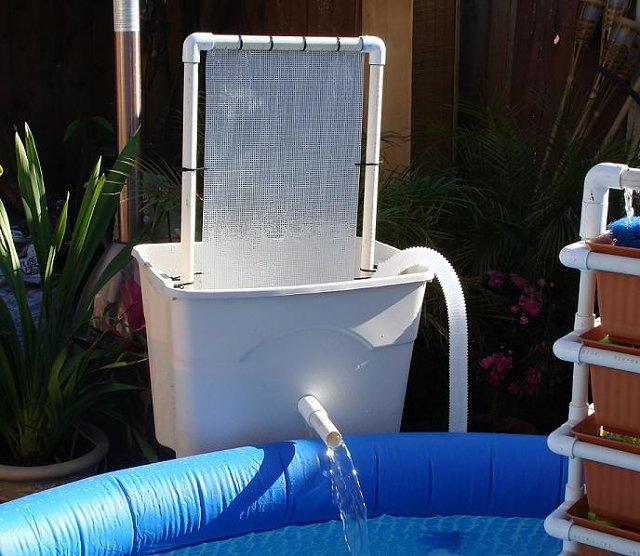
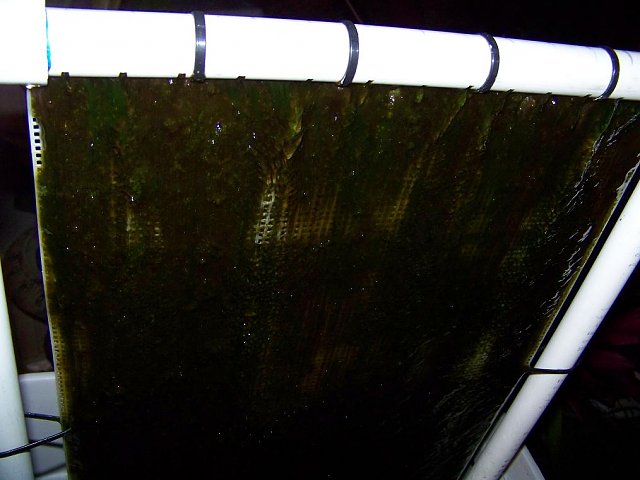
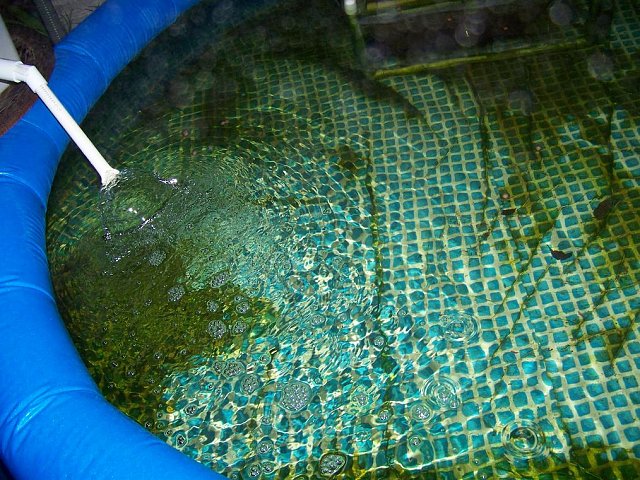
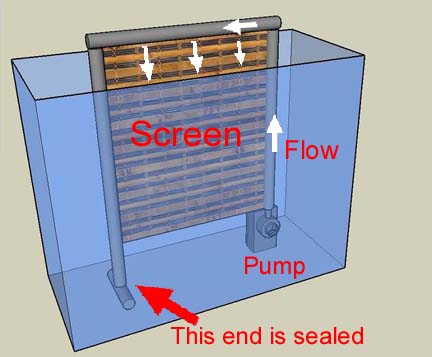
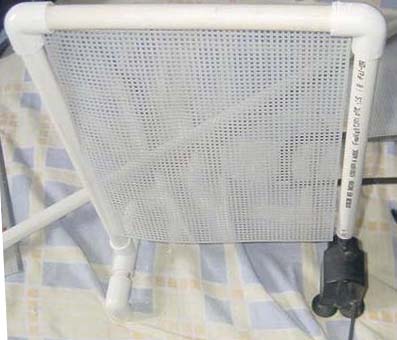
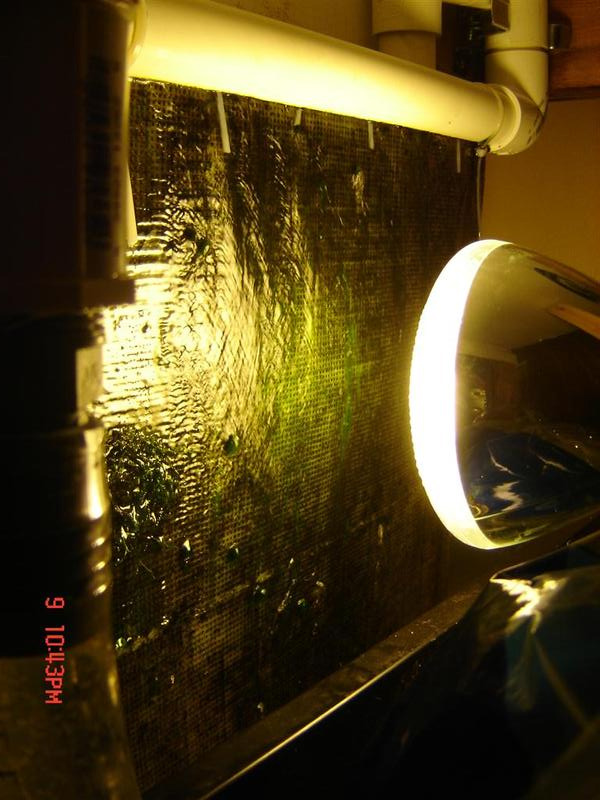
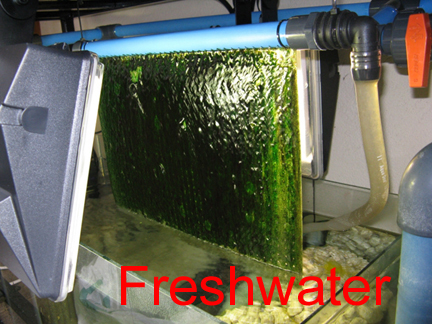
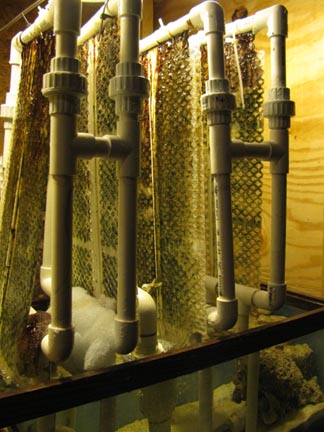
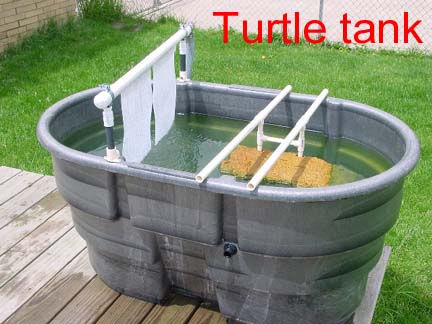
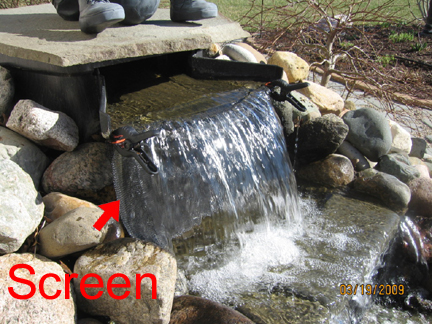
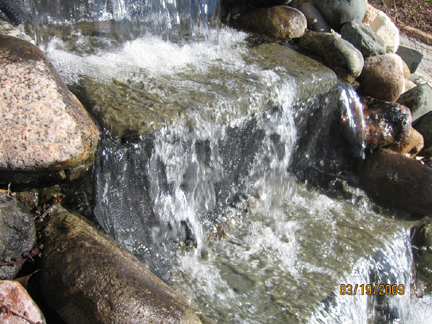
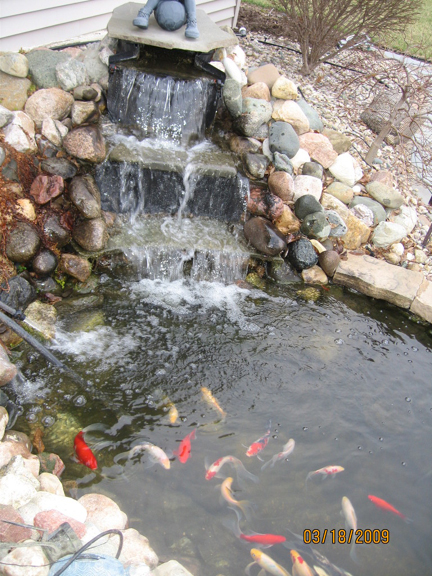
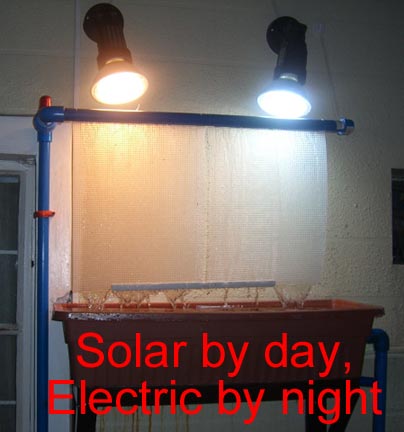
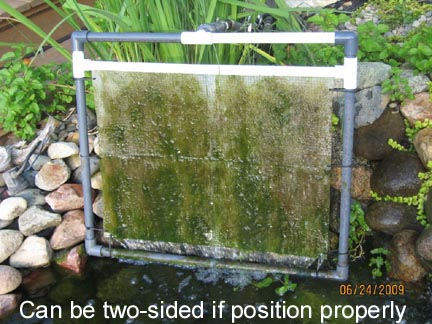

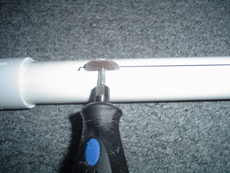
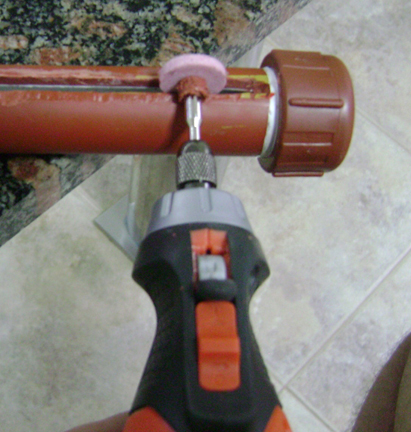
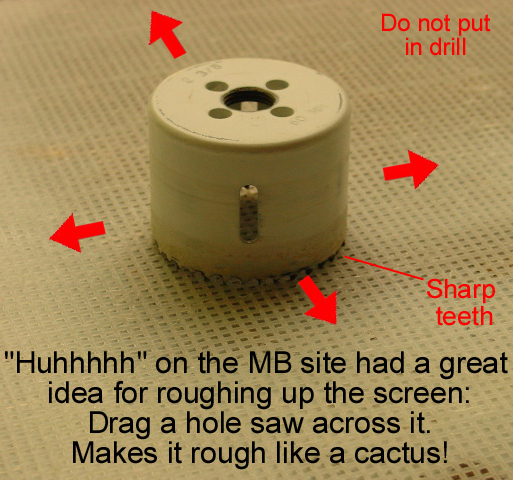
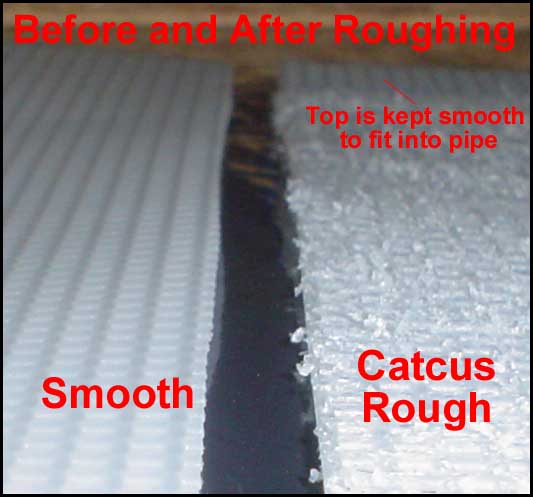
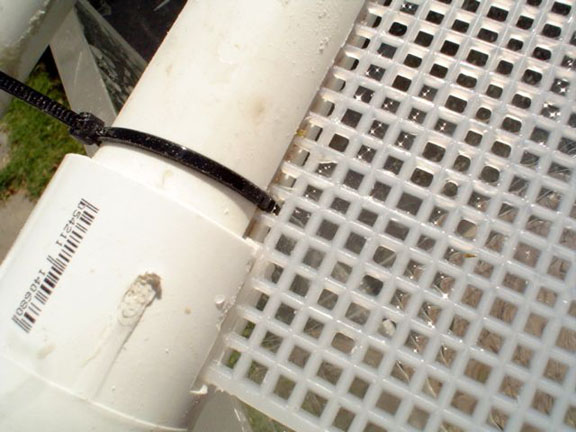

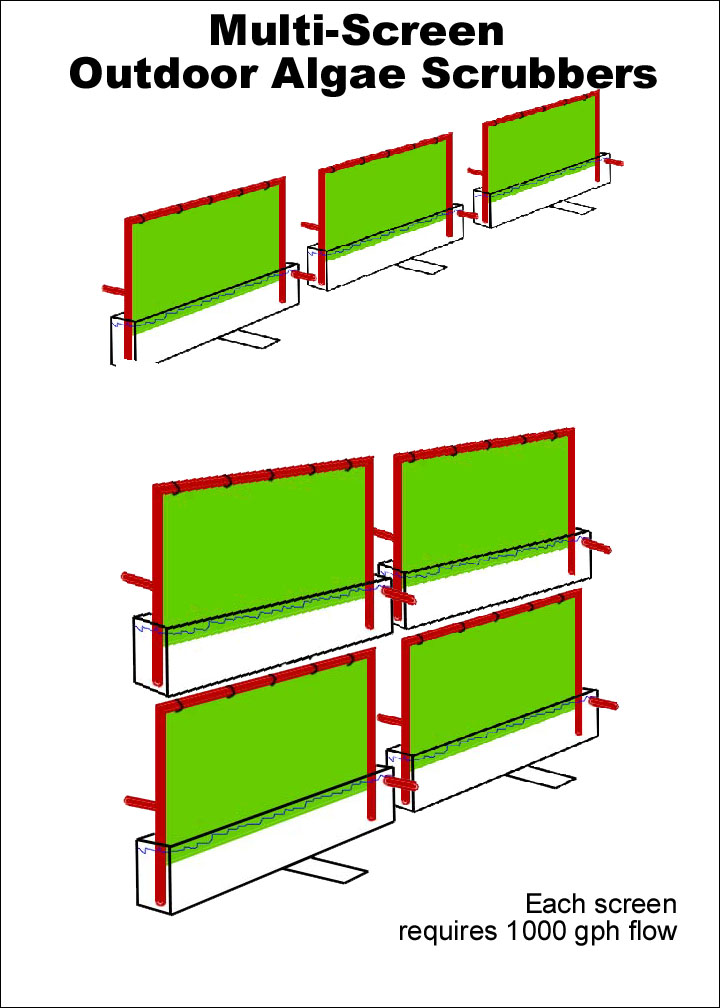
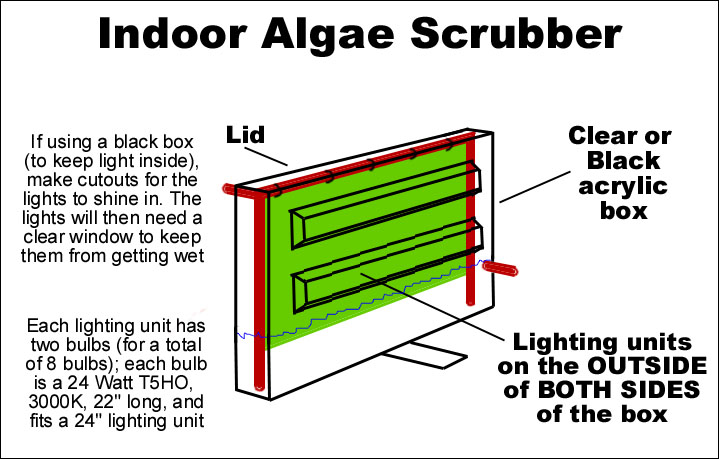
 Reply With Quote
Reply With Quote
